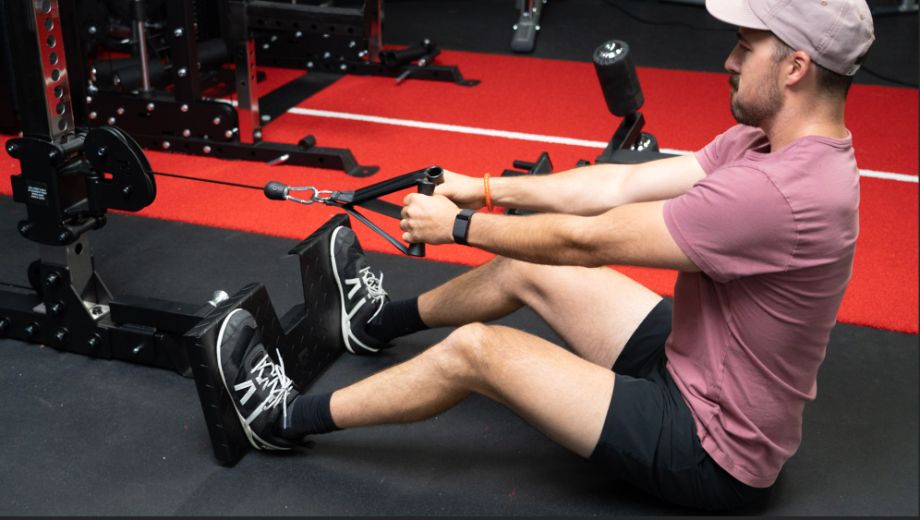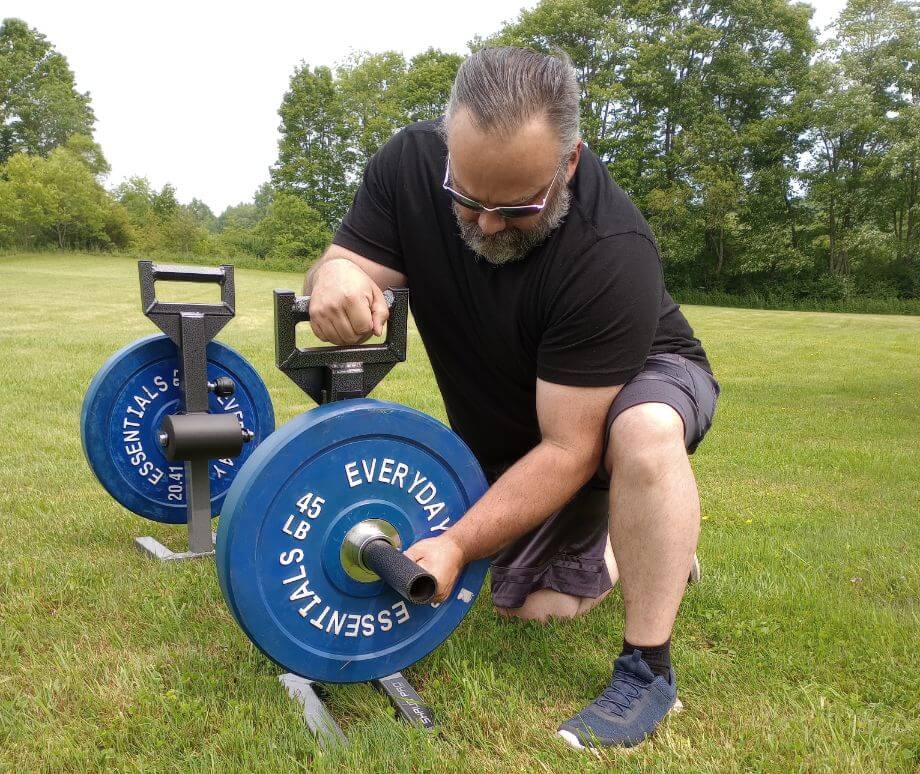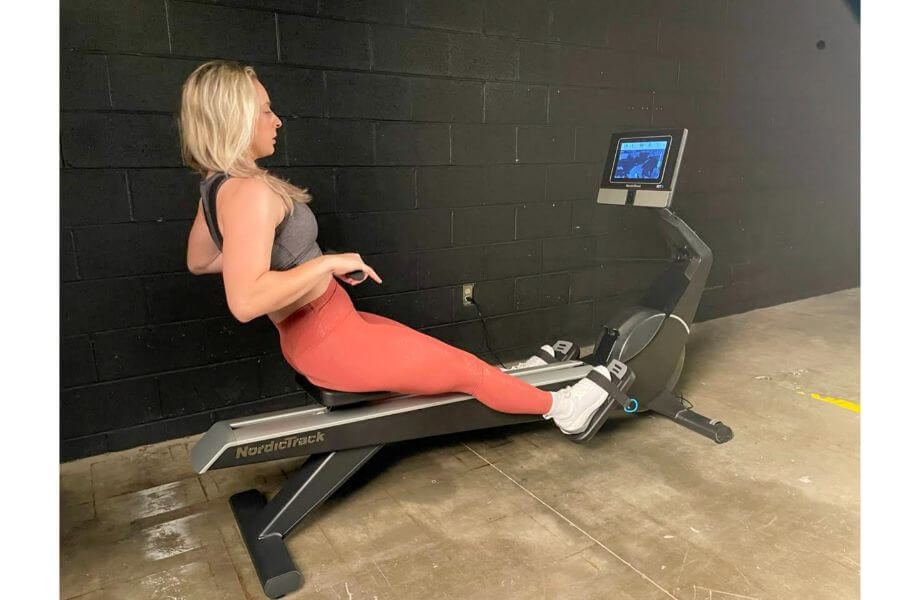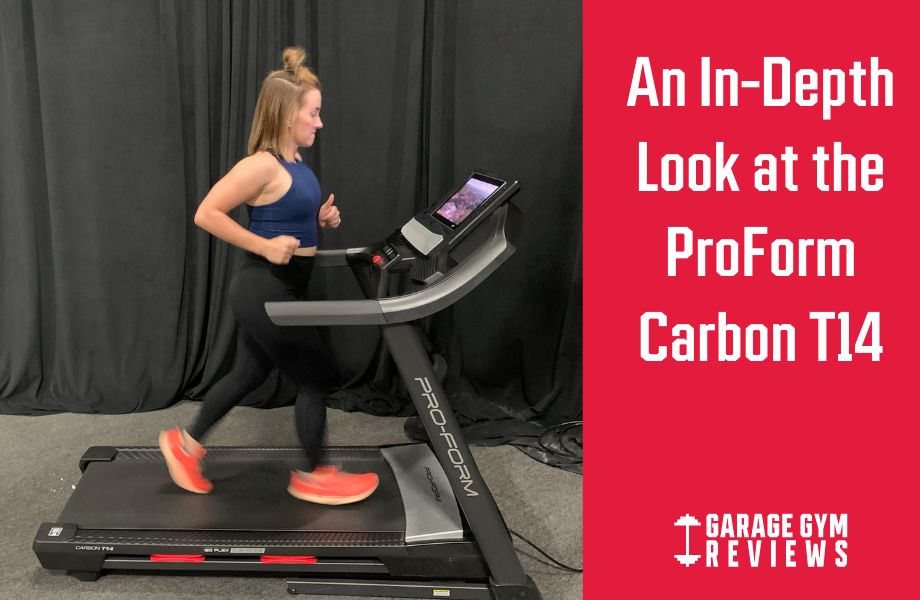You can get a great back workout using cables.
Yes, you read that right, and you don’t need to check the prescription on your glasses. I love bodyweight pull-ups and a good back workout with dumbbells or barbells. But, there’s a time and a place for these and there’s a time and place for a good cable back workout.
The cables are safer, which is ideal for beginners or those with injuries. With cables, you’re able to isolate muscle groups better (muscles like traps or rear delts, which can get ignored during free weight training). And of course, there are tons of exercise variations, all of which can be easily adapted with a change in the position of the cable machine or an alternative grip.
Are you sold? I want to think so. If you’re ready to build a wide back using cables, then let’s get straight into the eight best cable back exercises for you to try.
RELATED: The Best Cable Machines
8 Best Cable Back Exercises
These aren’t just great cable movements, these are some of the best back exercises. Let’s dive in.
Seated Cable Row
Why Do It: The seated cable row machine works the upper back muscles, including the rhomboids, latissimus dorsi, erector spinae, and lower trapezius. You’ll also activate the biceps, triceps, and core during this exercise. I like that you can play around with various attachments to target different muscles in your upper body.
How to Do It:
- Before sitting down, pick the attachment you want to use (the V-grip is the most common, but I also like to do seated rows with a straight bar or a wide bar).
- Get onto the seat or floor, making sure the pulley is at chest height.
- Stick your chest up and adjust your positioning so that there’s a slight bend in your knees.
- Lean forward slightly to take hold of the attachment (your arms should be straight here).
- Retract the shoulder blades, and then pull the attachment towards your lower chest region.
- Pause, then slowly return the attachment to the starting position.
- Repeat for the desired number of repetitions.
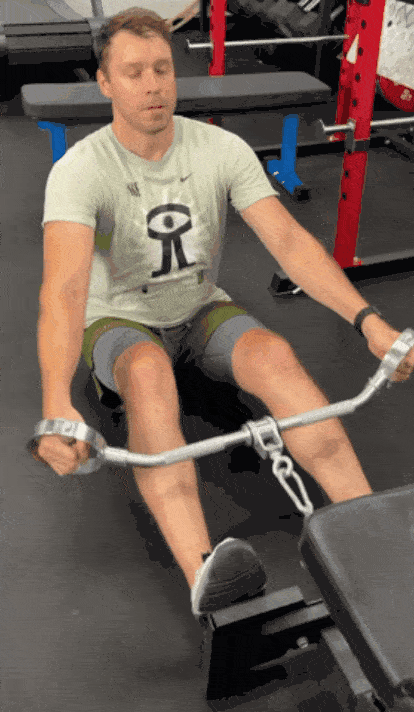
Single-Arm Cable Row
Why Do It: Because you’re doing one side at a time, this row exercise may help to fix muscle imbalances. This is something that you don’t get when training with dumbbells or doing the barbell row. Additionally, it’s a lot easier on the rotator cuffs when compared to other exercises.
How to Do It:
- Adjust the pulley on the cable machine so that it’s at chest height (you’ll want to use a handle attachment for this exercise).
- Take hold of the attachment with your left hand and step away from the machine until your arm is straight.
- With your feet hip-width apart, slightly bend your knees. Keep your head neutral.
- Now, retract your shoulder blades. Then, row the attachment toward the left side of your body. Keep your left elbow as close to your body as possible.
- Pause, then slowly reverse the motion so that you’re in the original position.
- Continue for reps, then do the same on the right side.
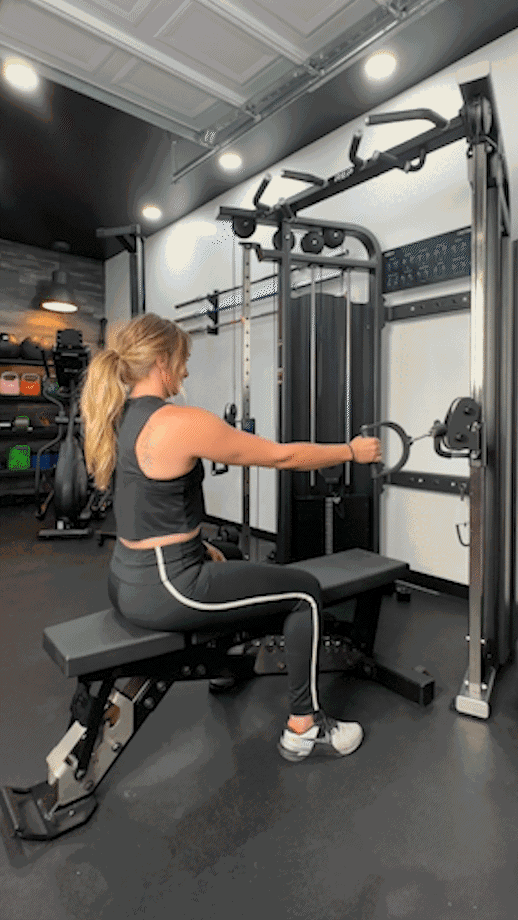
Lat Pulldowns
Why Do It: Wide-grip lat pulldowns are a staple in the bodybuilding world because they can build muscle in the latissimus dorsi and the biceps brachii. They may help you get better at bodyweight lat workouts like pull-ups, and barbell exercises such as bent-over rows.
How to Do It:
- With an overhand grip, take hold of the attachment. Your hands should be slightly wider than shoulder width apart and your palms facing away from you.
- Sit down on the seat with your head neutral.
- Focusing on activation of the lats rather than the biceps, bring the attachment down to your upper chest region. You’ll need to lean back slightly as the bar gets closer to your body.
- Bring the attachment back up in a controlled manner.
- Continue for reps.
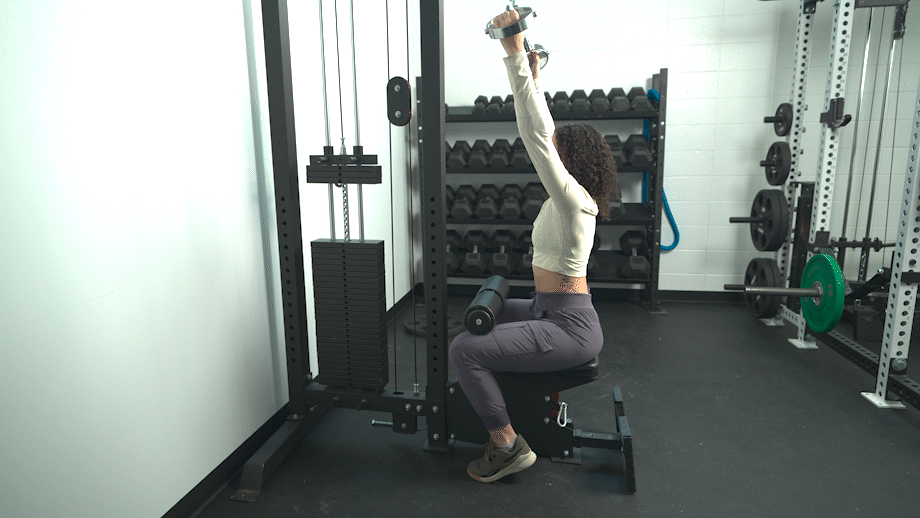
Cable Face Pull
Why Do It: With a cable face pull, you’ll activate your rear delts, rhomboids, and rotator cuff muscles. Strengthening your deltoids makes everyday life easier1, especially when it comes to overhead actions (for example, placing items on shelves). Face pulls may increase the range of motion through your shoulder joints.
How to Do It:
- Set the cable machine at the desired height using the rope attachment. Shoulder height is the most common, but I also like to do face pulls from a lower or higher starting position.
- Grab the rope with a neutral grip (your palms should be facing each other).
- Take a few steps back until your arms are fully extended.
- Engage your core, squeeze your glutes, and stick your chest up. Then, pull the rope toward your face (hence the name!).
- When the rope gets near your face, open it so it doesn’t hit you but instead ends up on either side of your face. Pause here.
- Repeat.
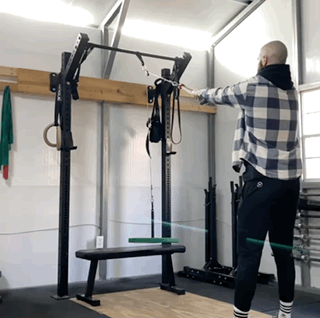
Cable Shrugs
Why Do It: Cable shrugs primarily target the trapezius muscles. The trapezius has upper, middle, and lower groups of fibers, and is responsible for stabilizing and moving the scapula2. Plus, bigger traps look good, too!
How to Do It:
- Adjust the cable machine to the lowest position, attaching a rope or straight bar (I prefer a rope myself but both work).
- Grab the attachment and take a small step away from the machine. You’ll want a neutral grip with your palms facing each other if you’re using a rope, or an overhand grip if you’re using a bar.
- With your feet slightly narrower than shoulder-width apart, keep your arms straight. Activate your core and glutes, and keep your head neutral.
- Shrug the attachment so that your shoulders lift toward your ears. Squeeze.
- Bring the attachment back down until your arms are extended.
- Continue for reps.

Incline Cable Pullover
Why Do It: A variation of the dumbbell pullover, the incline cable pullover is a great addition to any workout routine because it works the majority of your upper body, including your lats, pecs, and core. It can add muscle (or hypertrophy) and strength in a simple but effective way.
How to Do It:
- Place an incline bench close to a cable machine (around a 45-degree angle on the bench).
- Amend the height of the pulley so that it’s close to the top. Attach a rope, straight, or slightly curved bar.
- Lie down on the bench with your back facing away from the cable crossover machine. You may need to slightly adjust the bench to get the correct position.
- Take hold of the attachment with an overhand grip (your palms should be facing the ceiling in the starting position).
- Pull the bar down slowly until it doesn’t go any further. The end position will be near your quads area and your palms will now be facing the floor.
- Return to the starting position in a controlled manner.
- Keep going for repetitions.
RELATED: Try This Cable Biceps Workout
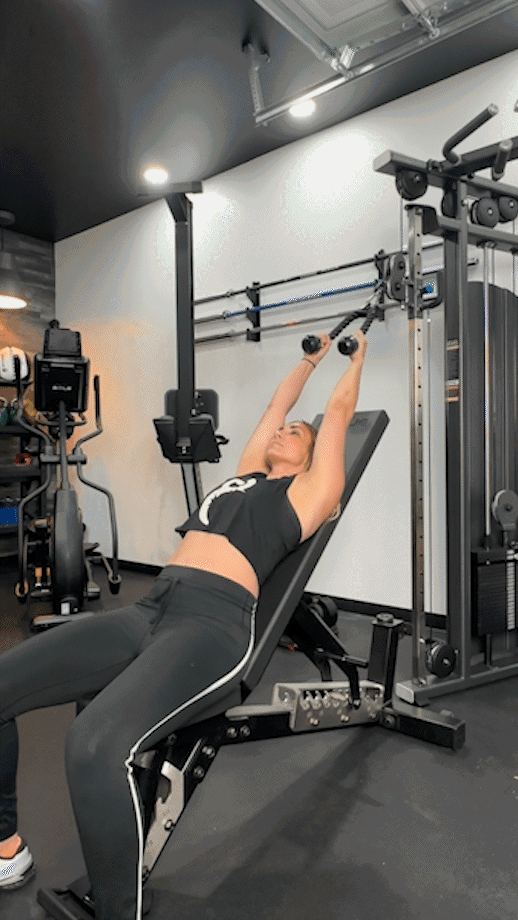
Straight Arm Pulldown
Why Do It: If you do these properly, you’ll place constant tension on the largest muscle in your back (the lats, of course!). Straight arm pulldowns (or cable pulldowns) are an isolation exercise and can be used to both warm up your back muscles or for serious muscle growth. The choice is yours.
How to Do It:
- Take hold of a straight or slightly curved bar on a cable machine, adjusting the weight so it’s at the desired level.
- The cable should be in the top position and you’ll be using an overhand grip (with your palms facing the floor). A wide grip is the most common but you can use a close grip.
- Take a couple of steps away from the machine.
- With straight arms, push the bar down in front of you. Focus on your lats and not your biceps with this pulling exercise.
- Slowly bring the bar to the top position.
- Repeat.
RELATED: The Best Lat Pulldown Machines
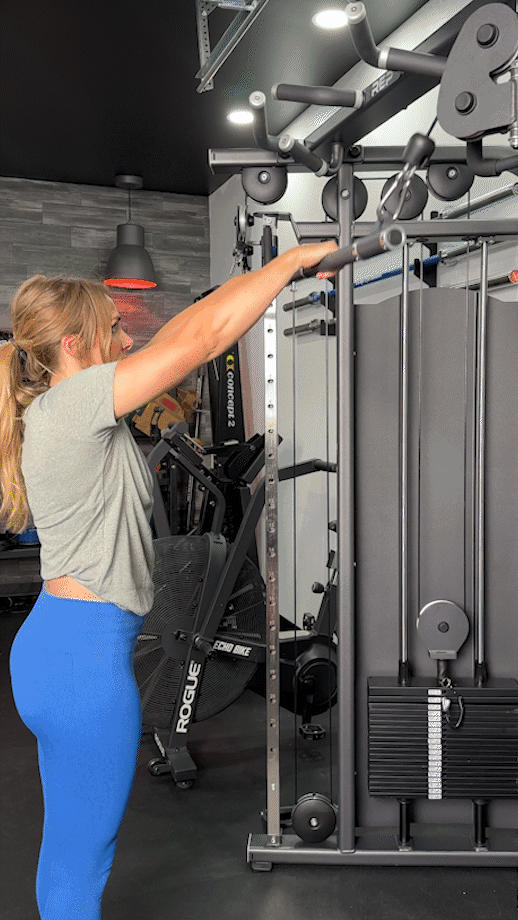
Reverse Cable Fly
Why Do It: You’re probably used to doing a cable chest fly, but the reverse cable fly is also packed with benefits. You’ll activate your rear deltoids with this exercise. This can not only help with other lifts in the gym (everything from overhead presses to deadlifts), but may also improve your posture, too.
How to Do It:
- Put handles on both sides of the cable machine, and adjust it to either chest or shoulder height (both work!).
- Take hold of the attachment closest to your left shoulder with your right hand, and then reach across and grab the other handle with your left hand.
- Stick your chest up and keep your head neutral.
- Position your arms so that they’re extended straight in front of you. This will be your starting point. Your arms will cross around the wrists or forearms region.
- With a slight bend in your elbows, pull the handles at the same time until your arms are fully extended to the side of your body. Pause.
- Slowly bring both attachments to the starting position.
- Continue for the desired number of reps.

Benefits of Cable Back Exercises
Now that you know my favorite cable back exercises, you’re probably ready to try them straight away. Oh, wait, not yet. First, you’re going to need to understand the benefits of adding them to your training program:
Better Range of Motion
Compared to free weights, you’re able to get a better range of motion when using cables for your back workouts3. You can also move in multiple planes of motion, for example, setting the cables higher or lower to target different muscle groups. Not only this, but your back muscles usually spend more time under tension when exercising with cables.
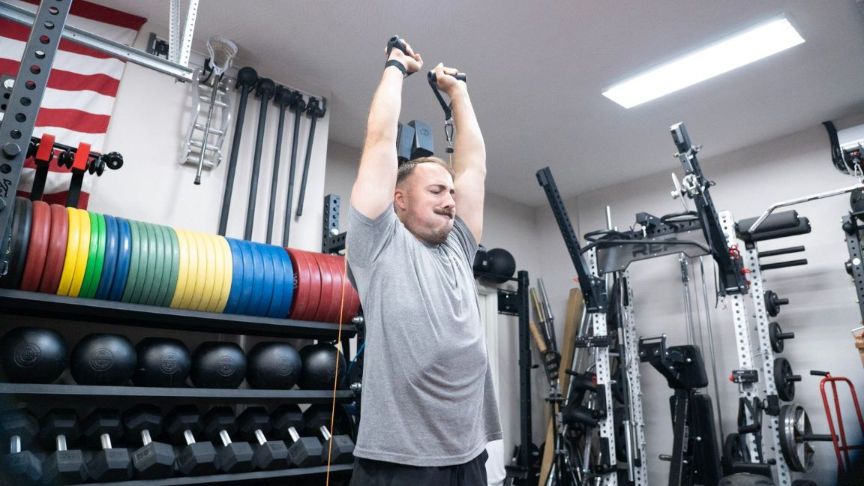
Isolates Muscle Groups
I love exercises such as pull-ups and dumbbell rows. The downside is that although they work your back, they also work lots of other muscle groups. This means that they’re usually much harder to do, especially when you’re tired. With cable back workouts, you can isolate muscle groups to target (some of which get ignored when training with dumbbells or barbell training). In some cases, isolating muscle groups can help to fix muscular imbalances.
Versatility
Cable back workouts are incredibly versatile. Beginners can do a full back workout with cables, and more advanced lifters can use cables at the start or toward the end of their workout. If you have an injury of any type that limits your range of motion, you can still get a good workout because cables adapt to your range of motion. There are tons of exercises you can try, and you can easily adapt these by changing your grip or the positioning of the cables.
What Are the Back Muscles?
The back muscles can be categorized into three groups4—the intrinsic or deep muscles, the superficial muscles, and the intermediate muscles.
The muscles in the superficial layer help with the movement of the upper limbs. These include the trapezius, latissimus dorsi, levator scapulae, and rhomboids. The intermediate muscles assist in the human respiratory function and are intimately associated with the ribs, and are composed of the serratus posterior inferior and the serratus posterior superior. Both the superficial muscles and the intermediate muscles make up the extrinsic back muscles, which are the primary movers in most back exercises.
And finally, you have the intrinsic or deep muscles, which are covered by a deep fascial layer5. The main muscle groups are the spinae muscles and the transversospinalis group, and these help with flexion/extension, side bending, and rotation.
RELATED: A Muscle-Pumping Chest and Back Workout
How to Train Back Muscles With Cables
You get the benefits of training the back with cables, as well as the anatomy of the back muscles. Below are my tips to make the most out of your cable back workouts:
- Reps and sets. In order to benefit from hypertrophy, aim for between six and 12 reps for each set. I’d recommend doing between three and five sets for each exercise, but this depends on the total number of exercises you do. If you do more, fewer sets are fine.
- Varying grips. The beauty of cables is that it’s easy to completely change an exercise by varying the grip or the position of the cable machine. Experiment with low, medium, and high positions, and use different attachments to see what works and what doesn’t.
- Training frequency. You’re going to want to train the back at least once per week to build strength and muscle mass. You can either do a full cable back workout or include some of these cable back exercises into your free weights workout. It’s up to you.
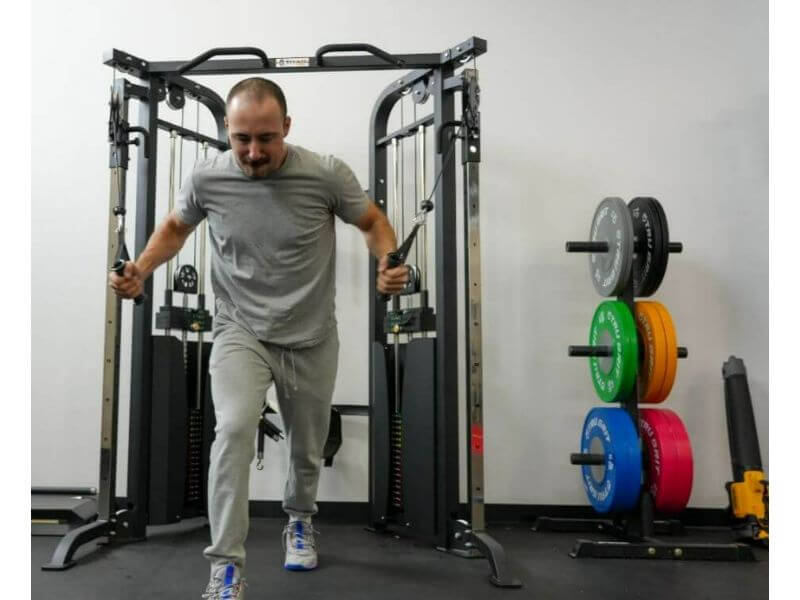
Cable Back Workouts: Final Thoughts
Cable back workouts allow a greater range of motion when compared to free weights. Not only this, but using cables means that you’re able to isolate specific muscle groups in the back. Train the back at least once per week if you’re looking to increase strength and build muscle mass, and experiment with different grips until you find what works.
Cable Back Workouts: FAQ
Are cable pulls good for the back?
Yes, cable pulls are a well-known exercise and are good for the back. They work your rear delts and traps in the upper back. Regularly doing face pulls may help you to get stronger at compound exercises such as deadlifts, bench presses, and overhead presses. Your posture may also improve, which is important for those who spend hours sitting at a desk every day.
What cable exercises work lower back?
There are cable exercises that work the lower back. These include cable deadlifts, cable good mornings, standing cable rows, cable pull-throughs, and more. However, in my experience, it’s not as common to train your lower back or lower body with cables (especially when compared to the upper body). Dumbbells, barbells, and machines are more often used to work the lower back. That being said, it can still be done with a cable machine.
How do you train lats with cables?
To train the lats with cables, try some or all of the following exercises: seated cable rows, single-arm cable rows, lat pulldowns, incline cable pullovers, and straight arm pulldowns. Aim for between six and 12 reps on each exercise and ensure that you’re getting a full range of motion to really activate the lats. You can also experiment with different grips to see what works best for you.
How do you do cable pulls for the upper back?
If you’re looking to do cable pulls for the upper back, set the cable machine at shoulder height and attach a rope. Select the desired weight, and then take hold of the rope with a neutral grip. Take a couple of steps backward, then pull the attachment toward your face. Open the rope so it doesn’t hit your face,
References
- Elzanie A, Varacallo M. Anatomy, Shoulder and Upper Limb, Deltoid Muscle. [Updated 2022 May 15]. In: StatPearls [Internet]. Treasure Island (FL): StatPearls Publishing; 2023 Jan-. Available from: https://www.ncbi.nlm.nih.gov/books/NBK537056/
- Ourieff J, Scheckel B, Agarwal A. Anatomy, Back, Trapezius. [Updated 2023 Mar 11]. In: StatPearls [Internet]. Treasure Island (FL): StatPearls Publishing; 2023 Jan-. Available from: https://www.ncbi.nlm.nih.gov/books/NBK518994/
- Signorile, Joseph F.1,2; Rendos, Nicole K.1; Heredia Vargas, Hector H.1; Alipio, Taislaine C.1; Regis, Rebecca C.1; Eltoukhy, Moataz M.1; Nargund, Renu S.1; Romero, Matthew A.1. Differences in Muscle Activation and Kinematics Between Cable-Based and Selectorized Weight Training. Journal of Strength and Conditioning Research 31(2):p 313-322, February 2017. | DOI: 10.1519/JSC.0000000000001493
- Henson B, Kadiyala B, Edens MA. Anatomy, Back, Muscles. [Updated 2022 Aug 25]. In: StatPearls [Internet]. Treasure Island (FL): StatPearls Publishing; 2023 Jan-. Available from: https://www.ncbi.nlm.nih.gov/books/NBK537074/
- Modes RJ, Lafci Fahrioglu S. Anatomy, Back. [Updated 2023 Feb 27]. In: StatPearls [Internet]. Treasure Island (FL): StatPearls Publishing; 2023 Jan-. Available from: https://www.ncbi.nlm.nih.gov/books/NBK539746/



